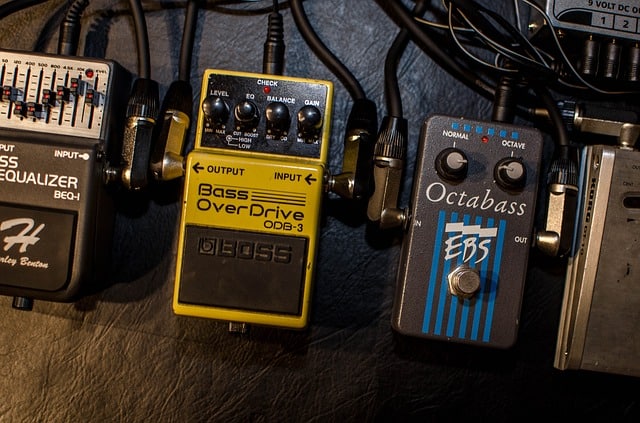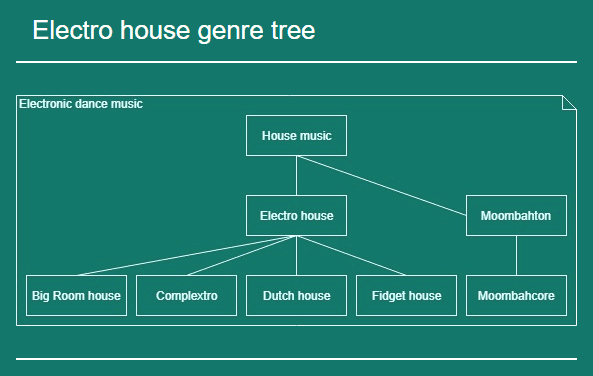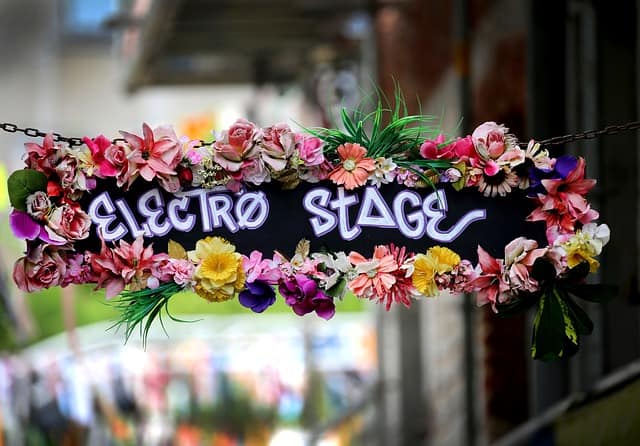There are many electronic dance music genres, and one of them is electro house. The electro house genre has some characteristics, an history, and some subgenres. This post provides these three things in an overview by which we can understand the genre better.
What is the electro house music genre? Electro house is a subgenre of house music, and house music is a genre of electronic dance music (EDM). Moreover, the genre is a blend of two music genres, but there are two possibilities for such a blend, and both possibilities are correct since it is opinion based. These two possibilities are:
- A blend between the EDM genre house and the not EDM genre electro
- A blend between the EDM genres house and electroclash
Electro house is a popular and interesting music genre, and we can find probably all the information we want to know about the genre in this post. We can find this information divided into three sections: characteristics, history, and subgenres. Also, the post has a section for related questions.
Characteristics
Each electro house track (song) has some characteristics. However, a characteristic is not a requirement so we can have an electro house track without having all the characteristics. For example, we can have such a track without having melodic elements.
Here follow some electro house characteristics, which I gave a number so I can reference each of those characteristics:
- A tempo between 125 and 135 beats per minute (BPM).
- Has a heavy bass, and such basses often sound buzzing. Furthermore, a method by which we can use to make such bass is to use sawtooth waves (with a synthesizer or as a sample) and place distortion after it (can be in the synthesizer or with a plugin).
- Has large sounding bass drum (kick) sounds in a four-on-the-floor pattern (a kick on the start of every beat). Such kicks are longer in duration compared to kicks in many other genres.
- It sometimes sounds in a way a lot like tech house.
- Melodic elements.
- Has samples en synthesizer sounds influenced by the not EDM genre electro (also known as electro-funk).
Requirements for an Electro House Track
It is hard to define in characteristics when a track is an electro house track. For example, if a track has a 128 BPM tempo and melodic elements, then it could still be a different genre than electro house.
Some characteristics are more electro house specific than others, which are 2, 3, 4, and 6. I almost know for sure that every electro house track needs at least one of these more specific characteristics. However, it is not official or something like that.

Influential Music Genres
Many people describe the electro house genre as a fusion genre. Moreover, when they do describe it as a fusion genre, then they mean it in one of these two ways:
- It is a fusion between the EDM genre house and the 1980s style electro, which is not an EDM genre.
- It is a fusion between the EDM genres house and the 1990s electroclash. Furthermore, electroclash is a fusion between the EDM genres techno and synth-pop, and the not EDM genres electropop and new wave.
Incorrect Characteristics
Some people mean with the word “electro” the same as “hard electronic dance music,” which is not correct. We can assume that “hard electronic dance music” is the harder EDM genres since it has not an official definition. Many people see the genre hardstyle as a harder EDM genre, and this genre has nothing to do with electro.
History
The history of the electro house genre is in a way pretty unknown. The genre has an extreme amount of tracks, which we can order on release date by which we get a history of released tracks. However, it is not that simple.
There were also electro house tracks released before they were called electro house. Those tracks have the house genre label, but they have electro house characteristics in such a way that they are electro house. Maybe there are even electro house tracks that didn’t have the house genre label.
As far as I know, the first officially labeled electro house track is unknown. Also, the first not labeled electro house track, but yet is, is also unknown.
There are at least three tracks that we can see as early examples of the electro house genre and are labeled correctly, these tracks are:
- Arrivers – Dark Invader. Released in 1996.
- Basement Jaxx – Raw S*it. Released in 1997.
- Mr. Oizo – Flat Beat. Released in 1999.
There were are least three electro house tracks that made the genre way more popular, these tracks are:
- Released in 2002: Benny Benassi – Satisfaction. Because of this track, many people see the Italian DJ Benny Benassi as one of the first who brought electro house to the mainstream.
- Released in 2005 or 2006: Bodyrox Feat. Luciana – Yeah Yeah (D. Ramirez Radio Edit). In the UK top 40 singles charts, this track was on spot number one and spot number two.
- Released in 2006: Fedde Le Grand – Put Your Hands Up 4 Detroit
After the three tracks mentioned tracks above, there came new electro house producers. Such producers are: Afrojack, Knife Party, Feed Me, The M Machine, Yasutaka Nakata, Porter Robinson, and Dada Life.
The Moombahton Genre Invention
The DJ and a producer Dave Nada invented the genre moombahton. He did this invention by slowing down the track “Silvio Ecomo & Chuckie – Moombah (Afrojack Remix)” to around 108 BPM. This track is originally an electro house track and has a tempo of 128 BPM.
Dave Nada did the invention live, and he did it because he wanted to give the party audience a taste of the reggaeton sound.
Later the label Mad Decent released a slower version of the track “Silvio Ecomo & Chuckie – Moombah (Afrojack Remix).” This slower version is the track “Silvio Ecomo & Chuckie – Moombah (Dave Nada Remix).” However, that one version is slower than the other is not the only difference, since there is also a three-second track length difference.
Dave Nada also invented the genre name moombahton by combining the words “Moombah” and “reggaeton.” The word “Moombah” came from the track “Silvio Ecomo & Chuckie – Moombah (Afrojack Remix),” as mentioned above.
Moombahton
Moombahton is a subgenre of the house genre and is a combination of the genres Dutch house and reggaeton. You can find in the subgenres section of this post about why Moombahton is not a subgenre of the electro house genre. Also, you can read there more about the Dutch house genre.
Reggaeton is not an EDM genre and has nothing more in common (as far as I know) with electro house. For this reason, you can’t find any information here in this post about that genre.
Every moombahton track has the requirement that it has a tempo around 108 BPM, without such a tempo it is not moombahton. Moreover, the genre is defined by:
- A thick and spread-out sounding bassline
- Dramatic builds before drops
- It has a pulse by which we can do the two-step. Two-step is a dance move.
- Drum fills with a fast pattern.
There are many moombahton producers, and some of these include Dave Nada, Diplo, Dillon Francis, Munchi, and Major Lazer.
Moombahcore
Moombahton also has a subgenre which is Moombahcore.
The music genre moombahton has influences from other genres of music. These genres include breakcore, dubstep, gabber, and techstep. Moreover, moombahton is defined by:
- Chopped parts of vocals.
- Bass sounds influenced by dubstep.
- Extensive builds before drops.
There are many Moombahcore producers, and some of these include Feed Me, Knife Party, Noisia, Delta Heavy, Dillon Francis, and Zomboy.
Subgenres
Electro house has four subgenres and in this section follows an introduction to these subgenres.

Big Room House
The big room house genre is also known as “big room,” and is a subgenre of electro house. In the early 2010s, the genre gained more popularity. This popularity was especially visible at EDM-oriented events, like festivals such as Tomorrowland.
Some people say that Big Room House began to develop in a way that is was not a subgenre of electro house anymore, but this is not true. Big room house is subgenre is and was always a subgenre of electro house.
Big room house sounds like Dutch House, which is also a subgenre of electro house. Both genres are defined by:
- Have drop sections in the track structure
- Minimal use of percussion
- Regular beat patterns
- Bass drums with a sub-bass layer
- Simple melodies
- Synth-driven breakdowns
The track structure of a big room house track is similar to the track structure of an electro house track.
Some big room house producers include Martin Garrix, Hardwell, Ummet Ozcan, and Dimitri Vegas & Like Mike.
Complextro
The Complextro genre is a subgenre of electro house. Complextro has two characteristics, and some people think that they from the music genre dubstep. These characteristics are:
- Glitchy and complex sounding basslines
- Textures created by sharply cutting and switching between instruments in quick succession
The genre name Complextro is a combination of the words “complex” and “electro.” Porter Robinson invented this word combination, by which he could describe the music he was producing in 2010.
Porter Robinson mentioned that two types of music were an influence on his style of music. The first is chiptunes (video game music) and the second is 1980s analog synthesizer music.
Other producers of the Complextro genre include Adventure Club, Knife Party, Kill The Noise, and Lazy Rich. Also, Madeon, The M Machine, Mord Fustang, Wolfgang Gartner, Virtual Riot, and Zedd.
Dutch House (Dirty Dutch)
The Dutch house genre is also known as “Dirty Dutch,” and is a subgenre of electro house. Dutch house is an electro house style that originated in the Netherlands, from which it probably get the genre name. The genre became more popular in 2009 and Chuckie and Vato Gonzalez were the main pioneers.
Dutch house has influences from other styles/genres of music including Detroit techno, hip hop music, and some other urban styles of music. Furthermore, the genre is primarily defined by:
- Complex rhythms that producers make with Latin-influenced drum kits
- Low emphasis on basslines and how they sound
- High-pitched lead made by one or more synthesizers
Also, the genre has the same characteristics as big room house. The Dutch house genre has then the same characteristics as big room house with other Dutch house characteristics. So we can see the Dutch house genre as a more extended and as more described version of big room house.
Two other Dutch house producers are Afrojack and Sidney Samson.
Fidget House
The fidget house genre is also known as “fidget,” and is a subgenre of electro house. Jesse Rose and Switch (the house DJ from London), who are both DJ and producer, invented the name fidget house.
Fidget house has influences from other genres of music. These genres include Baltimore club, Chicago house, Detroit techno, hip hop, kuduro, and Pimba. Furthermore, the genre is defined by:
- Taken vocal snippets from something.
- Pitch-bend basslines that sound “dirty.”
- Rave-style stabs made with synthesizers.
- Glitchy sounding 4/4 beats.
There are many fidget house producers. Some of these producers include AC Slater, The Bloody Beetroots, Crookers, Hervé, Jack Beats, Jesse Rose, Sinden, and Switch.
The Moombahton Genre Mistake
Like mentioned above in the subsection “The Moombahton Genre Invention,” Moombahton is a subgenre of house and not of electro house. Also, that subsection has other information about the Moombahton genre.
Many people think that Moombahton is a subgenre of electro house, which is not correct. Those people think that because Dave Nada discovered the genre by slowing down an electro house track down to around 108 BPM. However, 108 BPM is too slow for an electro house subgenre, which you can also see in the characteristics section of this post.
Related Questions
What are the requirements for an electro house track (song)? There is not an official correct answer, but there are some characteristics that are more specific to electro house than to other genres. Probably every electro house track should have at least one of these characteristics, which are:
- Has a heavy bass, and such basses often sound buzzing.
- Has large sounding bass drum (kick) sounds in a four-on-the-floor pattern (a kick on the start of every beat). Such kicks are longer in duration compared to kicks in many other genres.
- It sometimes sounds in a way a lot like tech house.
- Has samples en synthesizer sounds influenced by the not EDM genre electro (also known as electro-funk).
What is the first electro house track (song) ever? The first electro house track ever, that is labeled as electro house is unknown. Also, the first electro house track ever, that is not labeled as electro house is unknown. A reason for that many electro house tracks don’t have the electro house label, is that nobody had invented the genre yet at the moment of labeling.
What are the subgenres of the electro house genre? The electro house genre has four subgenres, which are: big room house, Complextro, Dutch house (Dirty Dutch), and fidget house. Furthermore, some people think that moombahton is also a subgenre of electro house, but this is not true. The DJ and a producer Dave Nada invented the genre moombahton, which he did by slowing down the 128 BPM electro house track “Silvio Ecomo & Chuckie – Moombah (Afrojack Remix)” to around 108 BPM. However, 108 BPM is too slow for an electro house subgenre.


Very Informative.
Thank you my man
I am glad you like it 🙂
Handy info in one spot 😉
Thanks
Thank you for this article. This is an important topic.
Hi Markus
I really appreciate this post. It’s thorough! And even has a flowchart of electro house and its subgenres.
Came across your post while trying to figure out what genre to correctly label my track Auxylate as. I bugs me no end, and I’ve tried several times 😫
https://www.youtube.com/watch?v=g2qO6YnQXNU
Is it:
– Electro House?
– Progressive House?
– Melodic House?
– Future Rave?
– Something else? If then: what?
I simply can’t figure it out 🤯 It is, to me, 100% house. But it also has some hints of techno, as well as (to my ears) elements from psy-trance and tech-house.
The drop makes me think of electro house – it’s a very “shuffle-friendly” bassline there (notice the bassline changes, at that point in the track).
Input is DEEPLY appreciated from you (Markus) or anyone else coming across this comment section.
🙏
Hello Tazmanian Ninja. I understand your problem. Finding the genre(s) of a song can be hard.
Honestly, I am not 100% sure what genre(s) your song is. However, it is not future rave, techno, psytrance, trance, or tech house. I think it is an electro-house song. One reason (there are more reasons) is that the break and drop differ much (the break focuses on a pad, and the drop focuses on a bassline and percussion), which I often hear in electro-house songs.
Your song also has characteristics of the future house genre and bass house genre (https://www.beatport.com/genre/bass-house/91). There was a period when songs were wrongly categorized as progressive house songs, for example, “Swedish House Mafia – One”(https://www.decodedmagazine.com/what-is-progressive-house-2/). I believe (I don’t know for sure) that people categorize such songs in the mainstage genre (https://www.beatport.com/genre/mainstage/96) these days. Your song also has characteristics of the mainstage “genre.”
So you can label your song as electro house. Or label it as the genres electro house, future house, bass house, and mainstage.
To be more sure, you can listen on Beatport for similar genres (maybe I missed something). And for example, you can listen to mixes on YouTube, such as “electro house mix.”
Hopefully, I helped you a bit 🙂
Hey again Markus 🤗
Thank you so much for the interesting input! Really appreciate it 🙏
I certainly already have listened to dj mixes on YouTube and Beatport genre-based charts, before I wrote you. I agree it’s a good way to identify genres 👍
Yet this track is my own blend of different elements I’ve liked as a teen in the 90s, listening to things like NU-NRG, rave, breakbeat, acid techno, etc. So things like Montini Experience, Dj Quicksilver, Space Frog, Hardfloor, Dj Misjah, and even Smitten Records releases.
And then some elements from the 2000s, I liked: Ferry Corsten (Exhale), some Armin tracks (esp. the Rising Star remix of Sound of Goodbye – by Perpetuous Dreamer), etc.
As well as, of course, newer stuff:)
I totally agree the track also has some mainstage flava. Esp. the snare-roll in the breakdown. Yet it doesn’t share the overall vibe of de facto mainstage (EDM festival type) tracks, which seem to follow a very stereotypical formula, and use sounds I’d never use.
In the end, I filed it as melodic house, as that’s a genre a know and like, and the overall “mood” of Auxylate fits in, there. But also because I couldn’t find/see “electro house” as a featured genre, on Beatport…? Can you?
(Cos otherwise I agree with you, that electro house is a closer approximation for the track).
Hey Tazmanian Ninja, atm the electro-house genre is a bit harder to find (I did it with google). The melodic house genre seems a good fit for your track 🙂
https://www.beatport.com/chart/electro-house/614019
Your track has some mainstage things, in a good way. I see that you have much knowledge about EDM genres/music. I don’t see that a lot.
Thanks 😁 Can say the same to you! 🤗 I appreciate your in-depth, meticulous writings here. Your post about the progressive house genre being a great example.
It’s a bit odd how Beatport changes their featured/menu-linked genres like they do 🥴 For sure it’ll be nicer to chart in a featured genre, rather than one that has to be Google’d to be found 😅
It could lead to more genre-mislabeling. Artists and labels not wanting to end up in a somewhat “delisted” genre, picking a genre over another, based more on its prominence than its accuracy.
That said, genres do come and go, popularity-wise. So some regular pruning makes sense, on Beatport’s part.
Thanks again for the help with labeling my track! 🙏🌸